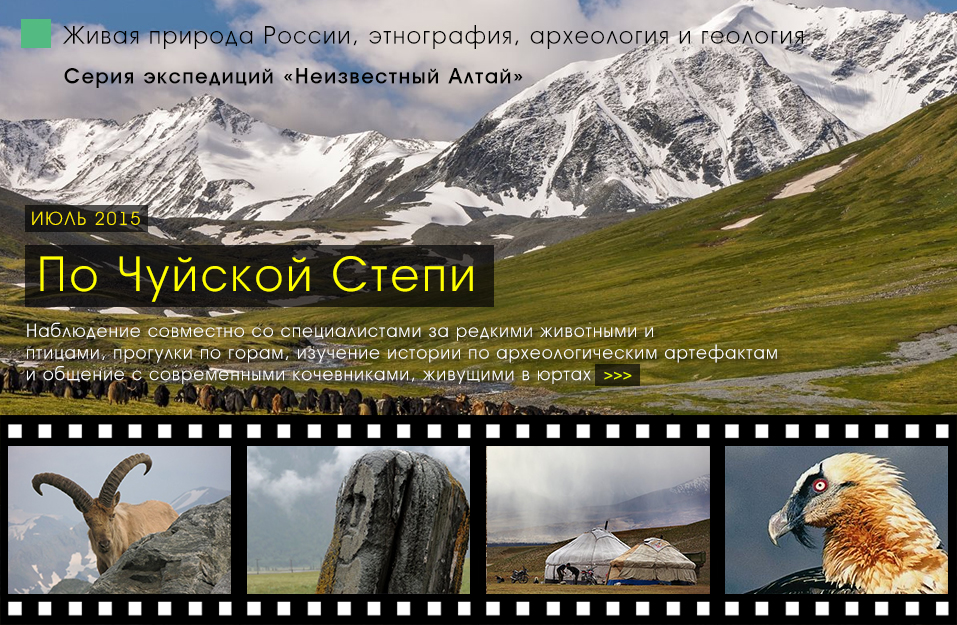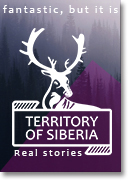The Chuya steppe. Recommendations for personal equipment
| What to take to a journey and what to leave at home |
| What will the weather be like? |
|
All of South Siberia is characterized by extreme continental climate: it is hot during the day, cold at night, and if the bright sun shines in the morning, in couple of hours it may rain and etc. That is why you must be prepared for any weather conditions: shorts and T-shirts for the heat and a jacket with waterproof trousers in case of rain and wind. The special features of the area will also include different altitudes (2000-2500 m), which changes intensity of ultraviolet rays of the sun, and its impact on the white skin is increased by the dry and clear mountain air. Officially the Chuya steppe is one of the driest and sunniest places in Russia, its average annual rainfall is less than 300 mm — a real desert in the mountains. The average daily temperature in July is around 20-25°C above zero, at night it falls to 6-9°C above zero. Here you can find the statistics on weather in Kosh-Agach (district center in the north-east of the Chuya steppe) for the past few years. But the thing is that most of the time we will be not in the steppe itself but in mountain valleys surrounding it, where the climate is more mountain-like — an average temperature is a few degrees lower. In the Elangash valley the night temperatures can drop to 0 — 1°C, and daily one stay at 10°C. In the area of the Lake Kindyktykol such surprises are also possible, but much less likely. In the valley of the Chagan-Uzun (where we will see Martian-like landscape) climate is classic Chuya steppe. In general, the time and place of our journey won’t be characterized with some hard extreme conditions. All weather difficulties are typical for an average travel — rain, wind and intense sunlight. |
| What personal equipment is required? |
|
1. Windproof and rainproof jackets and trousers — mandatory. |
|
We will do quite a lot of walking, so the upper layer of clothing should protect us from all the surprises of nature. You can use any outdoor clothes that can be purchased at sports stores. |
| 2. Trekking shoes – a must. |
|
We will do a lot of walking through rough terrain: rocks, loose steep clay slopes. The main requirement for footwear is an aggressive outsole. Sneakers, running shoes and fitness boots are not allowed (sandals can be useful for the steppe areas and for stops). It is desirable that the shoes protect and hold your ankle. Any suitable trekking shoes or regular sneakers with aggressive and hard soles are ok. Trekking shoes look like this:
|
|
We recommend having a change of shoes for the evening. No rigid requirements, but it should protect from the wet grass and traditional evening cold. |
| 3. Headdress — mandatory. |
|
A hat, panama hat, pith helmet, keffiyeh, bandana, or scarf — most importantly it should protect from the sun. In the Elangash valley a warm knitted cap will be useful. |
| 4. Warm jacket with hood (fleece) – mandatory.! |
|
It is useful in cold weather, especially in the evening and early morning when physical activity is minimal. You can even take a couple of sweaters or jackets and a feather (padding polyester) jacket (a very good option). |
| 5. Warm pants — – a must. |
|
In case of a cold snap you can use any fleece pants or usual woolen tights. |
| 6. Sleeping bag — mandatory. |
|
You should take the bag with the comfort temperature below -6°C and even lower. Please note that we indicate the comfort temperature, not the extreme one. It should also be noted this does not mean that there will surely be such temperatures. The thing is that all these figures are written by manufacturers using some strange averaged indicators (for instance, the majority of persons testing the sleeping bag felt ok at temperature of -10 in some unknown surrounding conditions) and, therefore, it is not recommended to trust these markings entirely. Actually if you have a night temperature in the region around 6 — 7°C (which we will experience in the Chuya steppe) it feels warm and nice in sleeping bags with the comfort temperature of -2°C to -10°C –, but in sleeping bags with comfort temperature of +6-7°C people usually feel cold, especially girls. Alternatively, you may take two sleeping bags of higher comfort temperature and sleep in two at once. Or sleep in one of them and use the second as an additional blanket. |
| 7. Sleeping pad ( camping mat) — mandatory. |
|
For comfort sleep in tents. |
| 8. Head flashlight — recommended. |
|
In the evening it is very convenient, especially during the late setting up of the camp, walking in the twilight, etc. |
| 9. Thermal underwear – recommended |
|
It is convenient during physical activity since it removes moisture from your body and is useful during sleep as another warming layer. |
| 10. Woolen socks — recommended |
|
For comfort and warmth during sleep. |
| 11. Gloves and sunglasses — at your discretion. |
|
If your skin is sensitive to the sun any sports gloves will be useful. In the Altay mountains the sun is intense and can easily get you a burn. |
| 12. Backpack — at your discretion |
|
Personal belongings can be brought in any travel bag, even in a suitcase — anything you like. During daily walks, you can take a small backpack to store a jacket for rainy weather, a water bottle and a light snack. |
| 13. A mug, a plate, a spoon — a must. |
|
Plastic or metal, but not porcelain or ceramic. A fork will be not as handy as a spoon. You can take a small folding knife, but do not forget to put in the luggage during the flight.
|
|
The plate like shown in the picture here has proved itself very useful; it is can be purchased in all Sportmaster stores. |
| 14. Personal hygiene items — a must. |
|
A couple of rolls of toilet paper, wet wipes, etc. |
| 15. Photographic equipment, video cameras, binoculars – recommended. |
|
One doesn’t have to explain that natural beauty is everywhere in the mountains, and a person with a camera in his or her hands has something to do for the whole day. For bird watching, it is recommended to have lenses with a focal length of 300-400 mm (larger and smaller distances are extremely inefficient). For landscape pictures, the lenses with 50 mm and lesser focal length are used, allowing framing all the view. A tripod is essential for shooting the night sky, sunsets, mountain rivers and group photos. One or two tripods would be enough for the group. A polarizing filter is required, gradient and ultraviolet ones are for your sole discretion. A bag (backpack) which can protect the equipment from rain and hard falls and bumps is obligatory. |
| 16. Sample containers – recommended. |
|
We expect to find prints of ancient flora and shellfish in the valley of the Chagan-Uzun. As a rule, it is a very fragile geological material and must be transported in hard containers, e.g., in a small food container (approximately 20 x 10 cm). It is very convenient to store the prints of petroglyphs in the drawing tube, because we will make a copy of Elangash rock drawings which are about one meter high. Also you can use a small notebook for collecting a herbarium. |
 |




